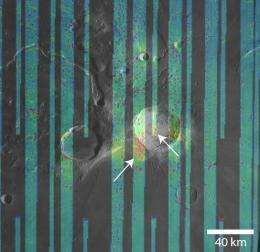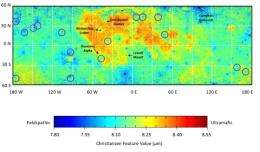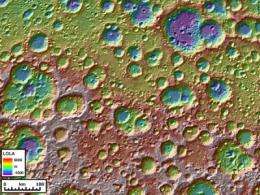Scientists report new insights into the moon's rich geologic complexity

(PhysOrg.com) -- The moon is more geologically complex than previously thought, scientists report Sept. 17 in two papers published in the journal Science.
Their conclusion is based on data from the Diviner Lunar Radiometer Experiment aboard NASA's Lunar Reconnaissance Orbiter (LRO), an unmanned mission to comprehensively map the entire moon. The spacecraft orbits some 31 miles above the moon's surface.
The new data reveal previously unseen compositional differences in the moon's crustal highlands and have confirmed the presence of material surprisingly abundant in silica — a compound containing the chemical elements silicon and oxygen — in five distinct lunar regions.
Every mineral, and therefore every rock, absorbs and emits energy with a unique spectral signature that can be measured to reveal its identity. For the first time ever, Diviner is providing scientists with global, high-resolution infrared maps of the moon, which are enabling them to make a definitive identification of silicates commonly found within its crust.
Co-authors on the research include David Paige, Diviner's principal investigator and a UCLA professor of planetary science; Benjamin Greenhagen, a scientist at NASA's Jet Propulsion Laboratory who earned his Ph.D. at UCLA under Paige; Timothy Glotch, an assistant professor of geosciences at New York's Stony Brook University; and Paul Hayne, who earned his Ph.D. at UCLA this year under Paige.
Lunar geology generally can be divided into two categories: the highlands, which are composed of anorthosite, an igneous rock rich in calcium and aluminum, and the maria (Latin for "seas"), which are composed of basalt, a volcanic igneous rock abundant in iron and magnesium. Diviner's observations have confirmed that most lunar terrains have spectral signatures consistent with compositions that fall into these two broad categories. However, they have also revealed that the lunar highlands may be less homogenous than previously thought.
In a wide range of terrains, Diviner revealed the presence of lunar soils with compositions more sodium-rich than that of the typical anorthosite crust. These soils reveal that there may have been variations in the chemistry and cooling rate of the magma ocean that formed the early lunar crust, or there could have been "secondary processing" (melting and solidifying multiple times) of the early lunar crust, Greenhagen said.
In several locations, Diviner has detected the presence of minerals that are found only in association with rocks that have undergone extensive magmatic processing — these are highly silicic minerals, such as quartz, potassium-rich feldspar and sodium-rich feldspar, which are rock-forming minerals common in the Earth's crust.
"The detection of silicic minerals at these locations is a significant finding because they occur in areas previously shown to exhibit anomalously high abundances of the element thorium, a proxy for highly evolved lithologies," Paige said.
"The silicic features we've found on the moon are fundamentally different from the more typical basaltic mare and anorthositic highlands," said Glotch, lead author of one of the papers. "The fact that we see this composition in multiple geologic settings suggests that there may have been multiple processes producing these rocks."

Some of the highly silicic regions, such as the Gruithiusen Domes, possess steep slopes and rough surfaces, suggesting they may be lava domes created by the slow eruption of viscous lava on the lunar surface — similar to the dome which formed on Mount St. Helens after its eruption, Glotch said.
In other regions, such as the Aristarchus Crater, the silicic spectral signatures are confined to craters and the materials ejected by their impact. This suggests that excavation of the subsurface caused by these impacts has exposed portions of plutons, which are magma bodies that solidified underground before reaching the surface.
How did such highly silicic materials form on a moon that is dominated by calcium-rich anorthosite highlands and iron and magnesium-rich basaltic maria?
Most of the highly silicic locations occur in the Procellarum KREEP Terrane (PKT), an area on the lunar nearside known for its extensive basaltic volcanism. This has led scientists to believe that the silica-rich material present in this region is a result of hot basaltic magma intruding into and remelting the lunar crust.
However, one of the regions, Compton Belkovich, occurs on the far side of the moon, far from the PKT and its associated volcanism. The location of the Compton Belkovich anomaly suggests that the conditions that led to sustained heat production and volcanism within the PKT may have been present at much smaller scales on the far side of the moon.
One thing not apparent in the data is evidence for pristine lunar mantle material, which previous studies suggested may be exposed at some places on the lunar surface. Such material, rich in iron and magnesium, would be readily detected by Diviner, Paige said.
However, even in the South Pole Aitken Basin (SPA), the largest, oldest and deepest impact crater on the moon — deep enough to have penetrated through the crust and into the mantle — there is no evidence of mantle material, he said.
The implications of this are currently unknown; perhaps there are no such exposures of mantle material, or perhaps they occur in areas too small for Diviner to detect, Paige said.

However, it is likely that if the impact that formed this crater did excavate any mantle material, it has since been mixed with crustal material from later impacts inside and outside the SPA.
"The new Diviner data will help in selecting the appropriate landing sites for future missions to return samples from SPA," Greenhagen said. "We want to use these samples to date the SPA-forming impact and potentially study the lunar mantle, so it's important to use Diviner data to identify areas with minimal mixing."
Diviner will continue to provide detailed infrared and solar reflectance maps of the moon for the remainder of the LRO mission. The LRO is managed by NASA's Goddard Flight Center in Greenbelt, Md.
Provided by University of California -- Los Angeles





















